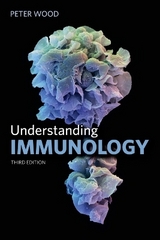
Understanding Immunology
Prentice Hall (Verlag)
978-0-13-196845-5 (ISBN)
- Titel erscheint in neuer Auflage
- Artikel merken
Contents
Preface
Acknowledgements
1 The threat of the body: the role and requirements of the immune system
1.1 The role and complexity of the immune system
1.2 Types of pathogen and how they differ
1.3 Disease production by pathogens
1.4 Conclusion
1.5 Summary
2 The immediate response to infection: innate immunity and the
inflammatory response
2.1 The response to infection
2.2 The immediate response to infection -- the innate immune system
2.3 Cytokines
2.4 The inflammatory response and cell migration
2.5 Cell migration
2.6 The inflammatory response
2.7 The acute phase response
2.8 Opsonins and phagocytosis
2.9 Interferons and natural killers
2.10 Summary
3 Specific immune recognition: the antibody molecule
3.1 Introduction to the specific immune system
3.2 Antibody structure
3.3 Recognition by antibody -- antigens and epitopes
3.4 Antibody classes
3.5 Antibody can be secreted or expressed on the cell surface of B lymphocytes
3.6 Summary
4 T lymphocytes and MHC-associated recognition of antigen
4.1 Overview of T lymphocyte subsets
4.2 The T cell receptor for antigen
4.3 The major histocompatibility complex
4.4 Recognition of antigen by T cells
4.5 Antigen processing and presentation by MHC molecules
4.6 Summary
5 Generation of diversity: how do T and B cells generate so many
different variants of their antigen receptors?
5.1 Introduction
5.2 The relationship between Ig and TcR genes and the proteins produced
5.3 Rearrangement of receptor genes in B and T cells
5.4 Summary
6 Anatomy of the immune system
6.1 Requirements of the immune system in vivo
6.2 The types of immune response
6.3 Anatomy of the lymphoid system
6.4 Lymphocyte recirculation
6.5 Summary
7 Cellular and anatomical aspects of antibody production
7.1 Overview of antibody production
7.2 Activation of CD4 T lymphocytes
7.3 Stimulation of B-cells by antigen and their interaction with helper Th (2-4 days after antigen)
7.4 Formation of germinal centres (4-14 days after antigen)
7.5 MALT and the production of IgA
7.6 Summary
8 Effector mechanisms: dealing with pathogens in vivo (1) Antibody-mediated responses
8.1 Humoral and cell-mediated immunity
8.2 Antibody-mediated effector responses
8.3 Neutralisation by antibody
8.4 Agglutination
8.5 Phagocytosis and killing
8.6 Complement
8.7 Antibody, complement and the opsonisation of microbes
8.8 Antibody-dependent cell-mediated cytoxicity (ADCC)
8.9 Summary
9 Effector mechanisms: dealing with pathogens in vivo (2) Cell-mediated immunity
9.1 Introduction
9.2 Cytotoxic T cells
9.3 Delayed-type hypersensitivity
9.4 Different effector responses have different costs to the hosts
9.5 Two major types of helper CD4 T cells
9.6 Summary
10 Immunological memory and vaccination
10.1 Immunological memory
10.2 Vaccines
10.3 Summary
11 Lymphocyte development and immunological tolerance
11.1 Why must lymphocytes be produced continually?
11.2 The production of lymphocytes: lymphopoiesis
11.3 Production of B lymphocytes
11.4 Production of T lymphocytes
11.5 Peripheral tolerance in T cells
11.6 Summary
12 Autoimmune diseases
12.1 Definition and terminology of autoimmune disease
12.2 Spectrum and clinical burden of autoimmune diseases
12.3 Immunological features of autoimmune diseases
12.4 Aetiology of autoimmune disease
12.5 Loss of immunological tolerance
12.6 Summary
13 Allergy and other hypersensitivities
13.1 Introduction
13.2 Type I hypersensitivity (allergy)
13.3 Clinical symptoms of allergy
13.4 Testing for allergy
13.5 Epidemiology of allergy
13.6 Why have IgE?
13.7 Treatment of allergy
13.8 Type II hypersensitivity
13.9 Type III hypersensitivity
13.10 Differences between type II and type III hypersensitivity
13.11 Contact hypersensitivity
13.12 Summary
14 AIDS
14.1 History and incidence of AIDS
14.2 The human immunodeficiency virus
14.3 Clinical course of HIV infection
14.4 Immunological events associated with HIV infection
14.5 Chemotherapy of HIV
14.6 HIV vaccines
14.7 Summary
15 Manipulating the immune system: vaccination, transplantation and tumours
15.1 Introduction
15.2 Transplantation
15.3 Using the immune system against tumours
15.4 Summary
Index
| Erscheint lt. Verlag | 8.2.2006 |
|---|---|
| Reihe/Serie | Cell and Molecular Biology in Action |
| Sprache | englisch |
| Maße | 234 x 158 mm |
| Gewicht | 492 g |
| Themenwelt | Studium ► Querschnittsbereiche ► Infektiologie / Immunologie |
| ISBN-10 | 0-13-196845-9 / 0131968459 |
| ISBN-13 | 978-0-13-196845-5 / 9780131968455 |
| Zustand | Neuware |
| Haben Sie eine Frage zum Produkt? |
aus dem Bereich



